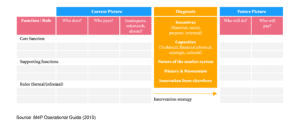PDF Download: Sustainability Analysis
In a nutshell: Sustainability analysis is a very simple tool for contrasting the current configuration of a market system with a desired future state. It helps you decide which activities will lead to sustainable behaviour changes by market actors. The Will/Skill matrix described below was originally developed by The Springfield Centre as part of the M4P Operational Guide.
Status: Optional Tool
Key principles: This tool foregrounds Facilitation by emphasizing that it is market actors themselves that make up the current and future picture of the system. It also implies Systems Thinking related to the roles, relationships and incentives of different market actors.
Preconditions and preparation: This tool is most appropriate after market mapping has taken place. It requires in-depth knowledge of the market system and individual actors, and is a useful bridge from market analysis into intervention design and adaptation.
Outputs
The main output is a completed version of the matrix below. This can be expanded upon: for example, a current picture of the overall market map, concentrated to a future picture of the overall market map. This can better reflect the reconfiguration of roles, functions and relationships in the market system – a more systemic picture than a simple linear table.
The tool consists of a simple matrix that asks two questions:
- Who ‘does’ what currently, and who will do what in the future?
- Who ‘pays’ for what currently, and who will pay for what in the future?

The market functions included in this table can be those that have been identified by market actors as being critical for improving inclusivity and market growth. For each ‘change’ from current to future state, the PMSD team should reflect on the possible facilitation tactics and activities they might try out to encourage actors to change their behaviour.
Outcomes / behaviour changes
The tool itself mainly clarifies the desired changes. It therefore needs to be linked to intervention strategies that have the best prospects of convincing actors to change, and reinforcing those changes.
Resources and templates:
BEAM Exchange; Who Does, Who Pays?